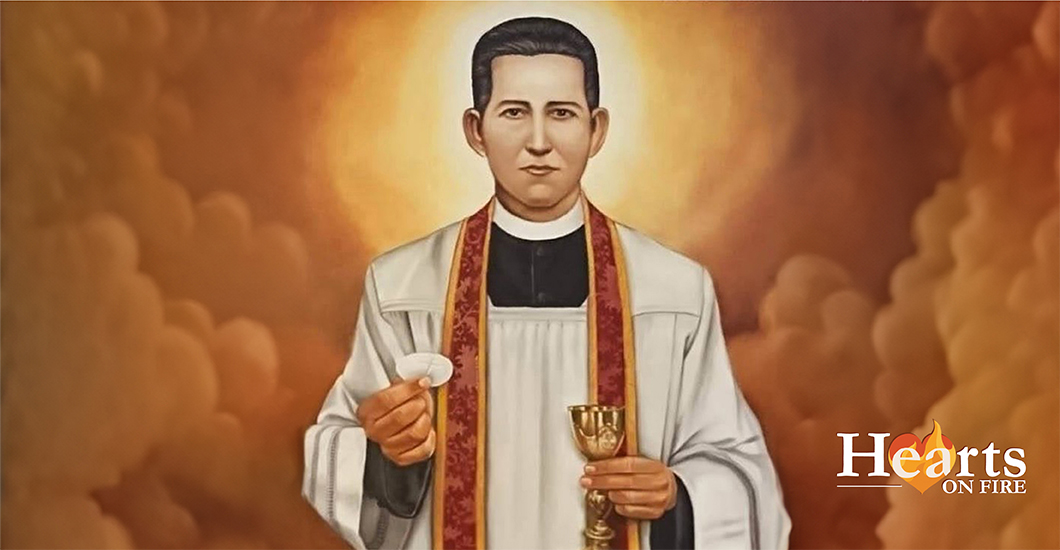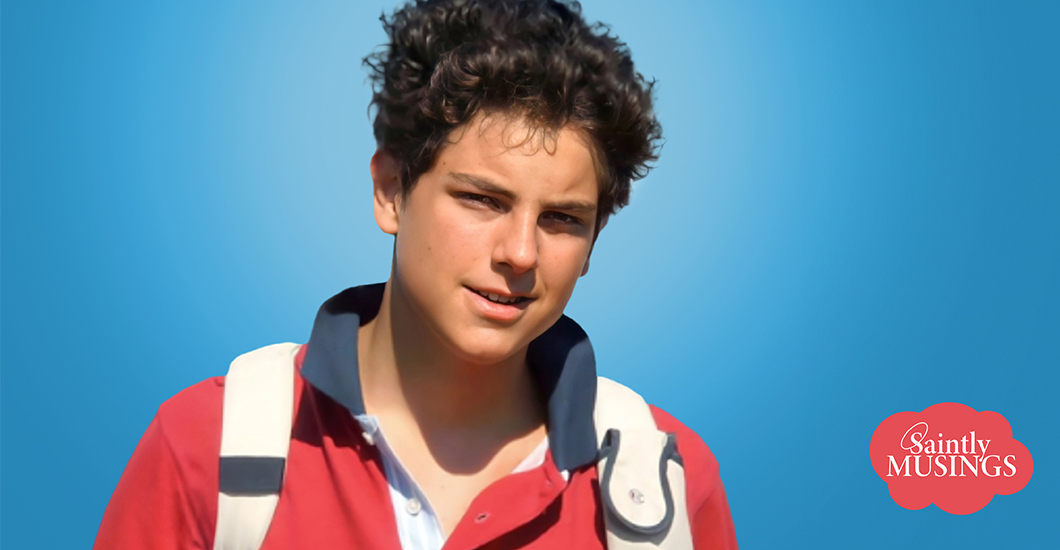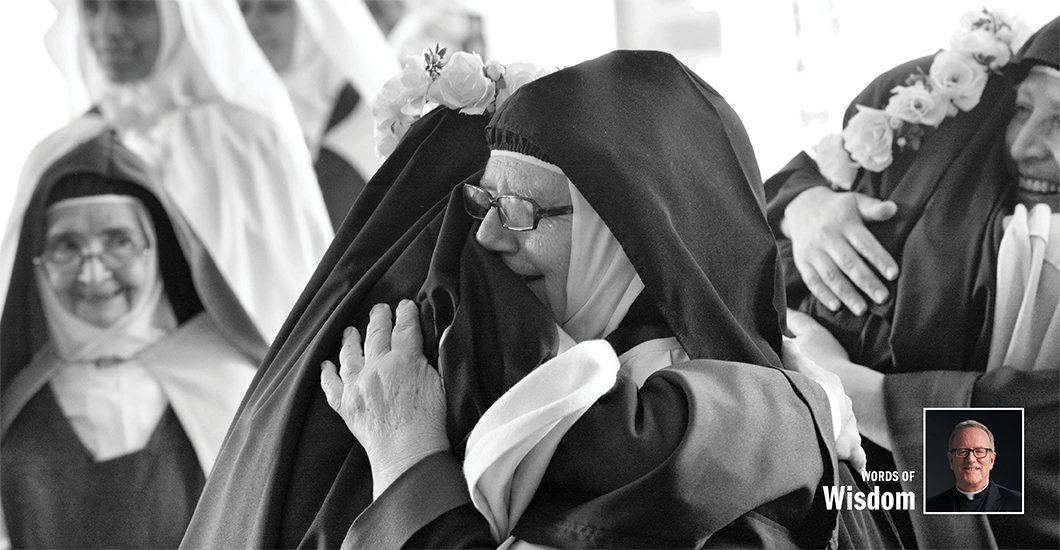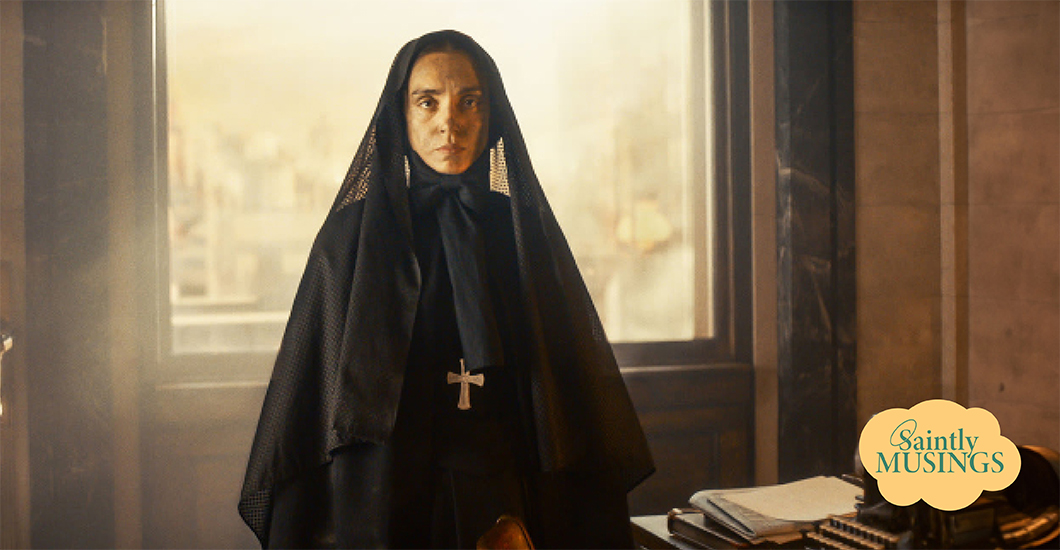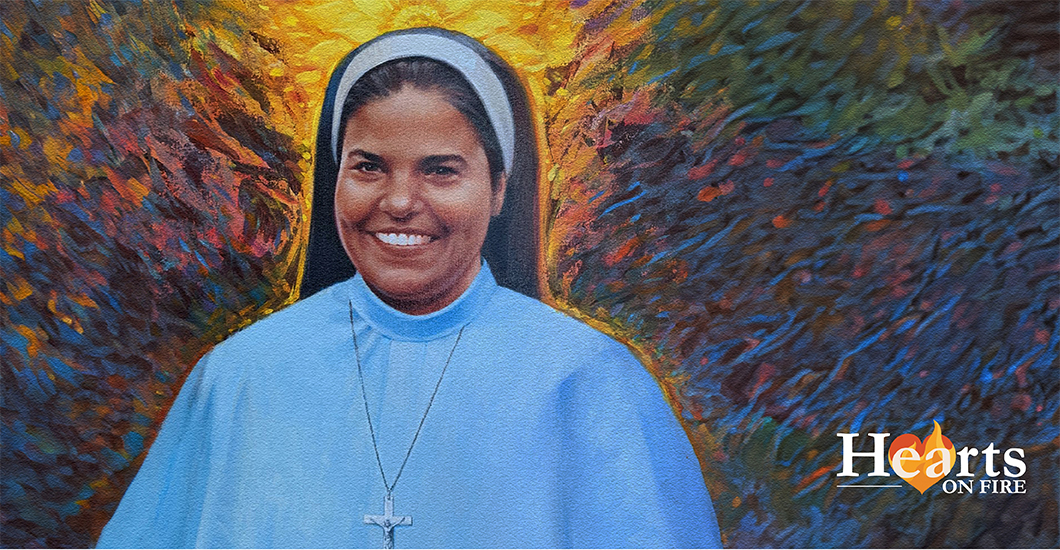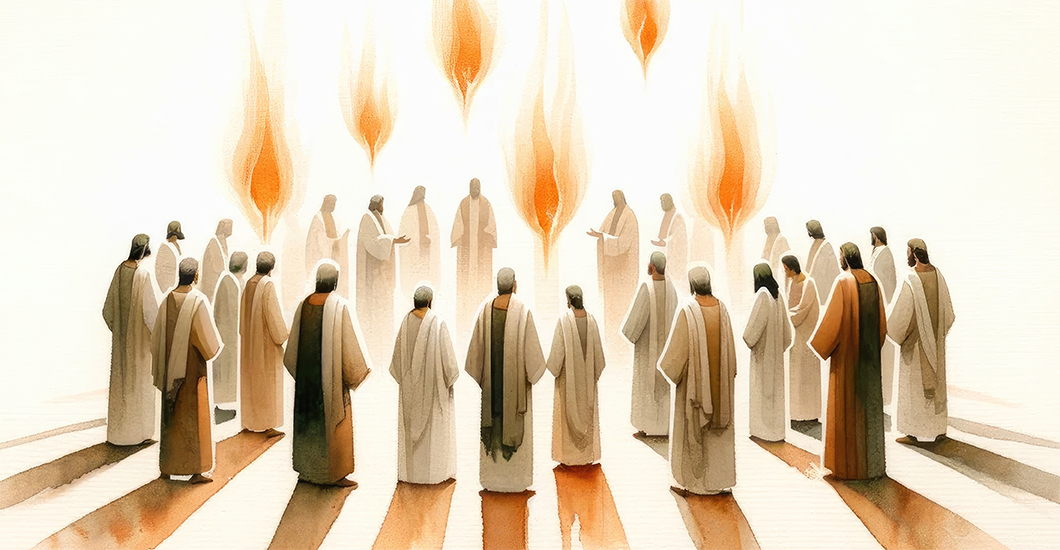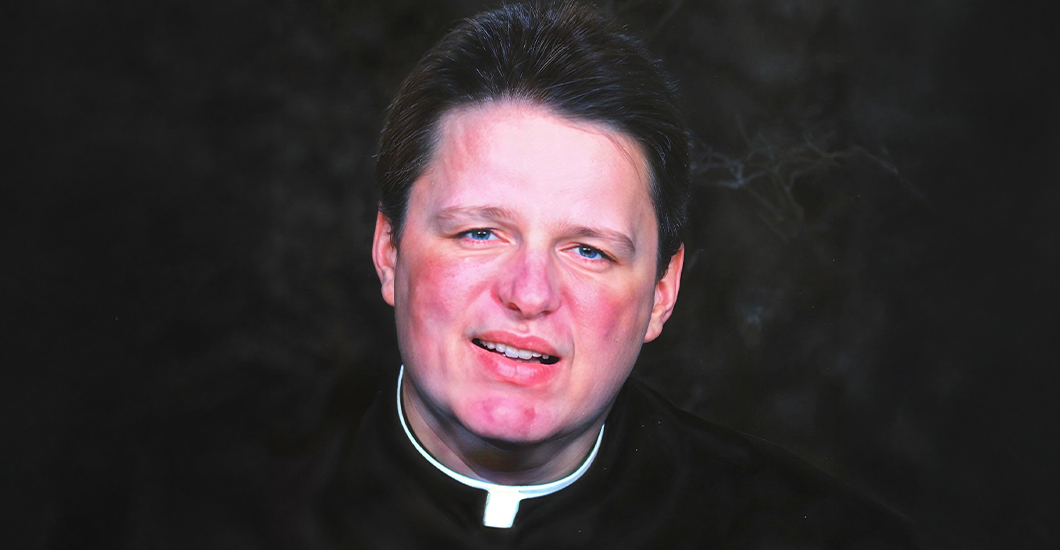I will Show You the Way
My vocation story begins when I was a child of about four or five years old, growing up in Lancaster, Ohio. My Aunt Mary Ellen purchased a new reel-to-reel tape recorder and she wanted to test out the recording device. So she invited my twin sister, Joan, and I to come over a number of times and record our voices. In order to get us to start talking, she would ask us various questions: Where do you live? What is your name? What is your mother’s name? What is your daddy’s name? Then she asked, “What do you want to be when you grow up?” Joan would always say, “I want to be a sister.” I would say, “I want to grow up and get married and have lots of children like my mother.” In my mind I knew that would be reversed, but I hesitated in saying that because I did not want to disappoint people if I did not become a sister.
When I was in second grade, I remember during my second confession the priest also asked me, “What do you want to do when you grow up?” This time, I told the truth: “When I grow up, I want to become a sister.” The priest said, “That’s a very good thought. What you need to do is pray and ask God what He is asking of you.” I took that very seriously. When I would go to Holy Mass on Sunday with my family, our missals in the pew had a prayer for vocations. I still did not want to tell anyone what I was thinking, so after communion, when my family members were bowing their heads in prayer, I would open the missal just enough to read that prayer and then close it quickly. This happened throughout my grade school years.
Then in sixth grade, during Lent, my teacher Sister Christopher showed a film strip on the passion and death of Jesus. In one scene, Jesus was shown suffering on the cross. The narrator said, “This is what your Savior has done for you. Now what will you do for your Savior?” It pierced my heart. I felt like I was the only one in the room. That was the key moment when I knew I had a desire to give myself completely to the Lord in some way. My vocation was a response to the cross. I knew then that it probably would be religious life. I did not understand it then but that was my thought.
During high school, I began to date and I got distracted, thinking perhaps I was supposed to get married. But on a retreat during my senior year, I decided to ask God—once and for all—what He wanted me to do. I remember kneeling down in my room, looking directly at a cross on the wall across from me. I heard the Lord say, “I’m calling you to be My own.” Again, my heart was pierced, and I knew then that I had to take action.
The only contact I had with religious sisters was with the Dominican Sisters of Saint Mary of the Springs in Columbus, Ohio, who taught me throughout grade school and high school. Whenever the postulants and novices would visit my school, I was always attentive and would ask questions. So, after my retreat, I told my home room teacher, Sister Sebastian, about my decision to enter religious life. She made an appointment for me to see a sister at the motherhouse in Columbus.
No one at my school knew about my vocation—yet. My father was a HAM radio operator, and he would often speak to other radio operators around the world. But sometimes his radio would interfere with our neighbor’s radio. One day during my last semester of high school, he told someone via radio that one of his twin daughters was going to enter the convent. Well, our neighbors found out and the next day at school there was a rumor that one of the Daugherty twins was going to enter the convent. Everyone knew it was me, and not Joan! Of course, I was upset with my father for spilling the beans.
I did end up visiting the motherhouse and made a decision to enter that fall, on September 8, 1959, at the age of eighteen. I made first vows July 9, 1962 and professed final vows July 9, 1967. During my first year of teaching, 1962-1963, I taught sixth grade in Steubenville, Ohio, to which I would return more than twenty years later. One of my first students was a nephew of Hollywood star Dean Martin! I taught for a total of eighteen years at elementary and Montessori schools in Ohio, New York, Pennsylvania and Michigan. I also served as principal for a total of six years at three schools in Newark, Coshocton and Columbus, Ohio.
It was in Newark that I was first exposed to the charismatic renewal, when families at a local parish there began to pray for me and invited me to go to prayer meetings with them. I eventually went to a Life in the Spirit seminar and received the Baptism of the Holy Spirit. One summer, I attended a Bible Institute at the College of Steubenville, because I knew it was charismatic. A master’s program in theology was just beginning there at the time. I had been sensing that I was going to work with young adults, so when I heard about the master’s program, my community allowed me to attend. After my first year in Steubenville, 1985-1986, a position opened on campus for a residence director for Trinity Hall. I felt that I was supposed to stay in Steubenville, so I applied for the position and got it. I would serve as the dorm director for four and a half years.
In those years on campus, I was being renewed in my own fervor in living the consecrated life. It was a call to live my religious life in a deeper way—to embrace it in a fuller way. I also was being imbued with Franciscan spirituality, although I did not realize it at first. It was awakening parts of myself that had not been awakened before. At some point, I became aware that God was calling me out of my own community. But I did not know what the next step would be. It was a frightening time in my life, not knowing what was next down the road. But I had all the assurances from the Lord that I would know when it was time.
Also during that time, the Franciscan Sisters, T.O.R. was founded. One of the original members of the community was another dorm director with whom I worked, one was a resident assistant and others were students I knew. I was very close to their founding. I watched the community grow and attract young women. I was the only woman religious on campus at the time, so whenever a young woman discerning religious life would go to the T.O.R. friars, they would send them to me. Often, they expressed a desire to join the new community. I remember thinking, “Gosh, it’s so easy for them.” My attraction to the community grew gradually.
The primary attraction was a call to a deeper contemplative prayer life. I knew that even before I felt called to join the new community, I also was drawn to their strong fraternal life, their focus on simplicity and poverty and the wearing of the habit.
I remained close to the community after it was founded—on August 15, 1988—attending Lord’s Day and dinner with them every Saturday and participating in a share group with the former dorm director, now the Reverend Mother. She and the other sisters invited me to join the community if I felt called. It had not dawned on me that it was possible for a Dominican to become a Franciscan. I spoke to my spiritual director, one of the T.O.R. friars, to help me discern what God was calling me to next. At first, he thought I was being renewed in my Dominican religious life, although I knew that was not the whole truth. There came a point when he invited me to go on a retreat he was directing for the candidates of the new community. On the retreat he asked me, “What do you think God is calling you to as the next step?” I said, “I think it’s to join the T.O.R. sisters,” and he said, “Go for it!” He helped me to take the necessary steps to request entrance into the new community. I moved in with the sisters in January 1991, entering into a time of discernment until I received the habit in July. I made final vows on March 18, 1995.
I am deeply grateful for how the Lord has worked in my life in all of its stages. He has led me down paths I never believed I would travel. My life as a Franciscan sister has been very blessed and fulfilling in so many ways. The following scripture passage is truly a reality in my life: “I will instruct you and show you the way you should walk; I will counsel you, keeping my eye on you” (Psalm 32:8).
Sister Jean Daugherty, T.O.R. Reprinted with permission from www.FranciscanSistersTOR.org.
Related Articles
The greatest evangelist is, of course, Jesus himself, and there is no better presentation of Jesus’ evangelical technique than Luke’s masterful narrative concerning the disciples on the road to Emmaus. The story opens with two people going the wrong way. In Luke’s Gospel, Jerusalem is the spiritual center of gravity— it is the locale of the Last Supper, the Cross, the Resurrection and the sending of the Spirit. It is the charged place where the drama of Salvation unfolds. So in walking away from the capital city, these two erstwhile disciples of Jesus are going against the grain. Jesus joins them on their journey—though we are told that they are prevented from recognizing Him—and He asks them what they are talking about. Throughout His ministry, Jesus associated with sinners. He stood shoulder to shoulder in the muddy waters of the Jordan with those seeking forgiveness through the baptism of John; over and again, He ate and drank with disreputable types, much to the chagrin of the self-righteous; and at the end of His life, He was crucified in between two thieves. Jesus hated sin, but He liked sinners and was consistently willing to move into their world and to engage them on their terms. And this is a first great evangelical lesson. The successful evangelist does not stand aloof from the experience of sinners, passing easy judgment on them, praying for them from a distance; on the contrary, she loves them so much that she joins them and deigns to walk in their shoes and to feel the texture of their experience. Prompted by Jesus’ curious questions, one of the travelers, Cleopas by name, recounts all of the 'things' concerning Jesus of Nazareth: “He was a prophet mighty in word and deed before God and all the people; our leaders, though, put Him to death; we thought He would be the redeemer of Israel; this very morning, there were reports that He had risen from the dead.” Cleopas has all of the 'facts' straight; there is not one thing he says about Jesus that is wrong. But his sadness and his flight from Jerusalem testify that he doesn’t see the picture. I love the clever and funny cartoons in the New Yorker magazine, but occasionally, there is a cartoon I just don’t understand. I’ve taken in all of the details, I’ve seen the main characters and the objects around them, I’ve understood the caption. Yet, I don’t see why it’s funny. And then there comes a moment of illumination: though I haven’t seen any further detail, though no new piece of the puzzle has emerged, I discern the pattern that connects them together in a meaningful way. In a word, I 'get' the cartoon. Having heard Cleopas’ account, Jesus say: “Oh, how foolish you are! How slow of heart to believe all that the prophets said.” And then He opens the Scriptures to them, disclosing the great Biblical patterns that make sense of the 'things' that they have witnessed. Without revealing to them any new detail about Himself, Jesus shows them the form, the overarching design, the meaning—and through this process they begin to 'get' Him: their hearts are burning within them. This is the second great evangelical lesson. The successful evangelist uses the Scriptures in order to disclose the divine patterns and ultimately the Pattern who is made flesh in Jesus. Without these clarifying forms, human life is a hodge-podge, a blur of events, a string of meaningless happenings. The effective evangelist is a man of the Bible, for the Scripture is the means by which we 'get' Jesus Christ and, through Him, our lives. The two disciples press Him to stay with them as they draw near the town of Emmaus. Jesus sits down with them, takes bread, says the blessing, breaks it and gives it to them, and in that moment they recognize Him. Though they were, through the mediation of Scripture, beginning to see, they still did not fully grasp who He was. But in the Eucharistic moment, in the breaking of the bread, their eyes are opened. The ultimate means by which we understand Jesus Christ is not the Scripture but the Eucharist, for the Eucharist is Christ Himself, personally and actively present. The embodiment of the paschal mystery, the Eucharist, is Jesus’ love for the world unto death, His journey into godforsakenness in order to save the most desperate of sinners, His heart broken open in compassion. And this is why it is through the lens of the Eucharist that Jesus comes most fully and vividly into focus. And thus we see the third great evangelical lesson. Successful evangelists are persons of the Eucharist. They are immersed in the rhythms of the Mass; they practice Eucharistic adoration; they draw the evangelized to a participation in the body and blood of Jesus. They know that bringing sinners to Jesus Christ is never primarily a matter of personal witness, or inspiring sermonizing, or even exposure to the patterns of the Scripture. It is primarily a matter of seeing the broken heart of God through the broken bread of the Eucharist. So prospective evangelists, do what Jesus did. Walk with sinners, open the Book, break the Bread.
By: Bishop Robert Barron
MoreI remember a childhood story in which God, about to destroy Earth because of humanity's wrongdoing, looked down, saw the lilies of the field praying for mankind, and extended the end of time. It was my wife's desire to attend daily Mass that led us to the nearby Carmelite Monastery. I was immediately struck by the pervasive stillness and a sense of tranquility. Through the grilled gates, these nuns looked like God's lilies on earth. As I was introduced to their daily life, I was surprised to learn that the sisters make vestments, altar breads, and greeting cards. They even stitch their own habits, grow their own fruits and vegetables, and look after the other elderly sisters. Most of the day is spent in silence, which helps them to open up to the Lord and pray. The sisters even meet up twice a day to talk and share. The power of prayer and its impact dawned upon me. The Church has a rich tradition of prayer, through which we deeply connect with God, whether it's through attending Mass, reciting the Rosary, or simply taking a few moments to reflect on God's presence in our lives. The experience of visiting the Carmelite Monastery was truly humbling. It helped me reflect on the power of prayer and the importance of dedicating one's life to serving others, and left me with a sense of peace and renewed faith.
By: Winner Varghese
MoreThe Mexican Revolution which began in the early 1920s, led to the persecution of the Catholic community in that country. Pedro de Jesus Maldonado-Lucero was a seminarian at that time. Once he became a priest, despite the risk, he stood with his people. He tended to his flock during a terrible epidemic, founded new apostolic groups, reestablished associations, and ignited Eucharistic piety among his parishioners. Upon discovering his pastoral activities, the government deported him, but he managed to return and continue serving his flock, in hiding. One day, after hearing the confessions of the faithful, a gang of armed men busted his hiding place. Father Maldonado managed to grab a reliquary with Consecrated Hosts as they forced him out. The men forced him to walk barefoot throughout the town, as a crowd of the faithful followed him. The city mayor grabbed Father Maldonado's hair and dragged him toward the city hall. He was knocked to the ground, resulting in a skull fracture that popped out his left eye. He had managed to keep his grip on the pyx until this time, but now it fell out of his hands. One of the thugs took some Holy Hosts, and as he forcefully stuffed the hosts inside the priest’s mouth, he shouted: “Eat this and see if He can save you now.” Little did the soldier know that just the night before, during the Holy Hour, Father Maldonado had prayed that he would happily give his life for an end to the persecution ‘if only he would be allowed to take Communion before his death.’ The thugs left him for dead in a pool of his own blood. Some local women found him still breathing and rushed him to a nearby hospital. Father Pedro Maldonado was born into eternal life the next day, on the 19th anniversary of his priestly ordination. Pope John Paul II canonized this Mexican priest in 2000.
By: Shalom Tidings
MoreWhen Andrea Acutis arranged a pilgrimage to Jerusalem, he thought that his son would be excited. Carlo was keen on going to daily Mass and reciting his prayers, so his reply came as a surprise: "I prefer to stay in Milan … Since Jesus remains with us always, in the Consecrated Host, what need is there to make a pilgrimage to Jerusalem to visit the places where He lived 2000 years ago? Instead, tabernacles ought to be visited with the same devotion!" Andrea was struck by this great devotion that his son cherished for the Eucharist. Carlo was born in 1991, the year the World Wide Web was invented. The little genius walked when he was just four months old, and started reading and writing at the age of three. The world would’ve looked at his intellect and dreamt of a bright future but the Divine had different plans. Combining his love for the Eucharist and technology, he left the world a great legacy of a record of Eucharistic miracles from across the world. He began the collection in 2002 when he was just 11 years old and completed it a year before he succumbed to leukemia. This young computer geek, at such a young age, even built a website (carloacutis.com), a lasting record, with all the collected information. The Eucharistic exhibition he pioneered was held in five continents. Ever since, many miracles have been reported. On his website, he has written the lasting mission of his life on Earth: "The more Eucharist we receive, the more we will become like Jesus, so that on this Earth, we will have a foretaste of Heaven." This Italian teenage designer and computer whiz is soon to become Saint Carlo Acutis. Widely known as the first millennial patron of the internet, Blessed Carlo continues to draw millions of youngsters to the love of Jesus in the Eucharist.
By: Shalom Tidings
MoreWhen she lost her mobility, eyesight, listening, voice, and even the sense of touch, what prompted this young girl to describe her life as ‘sweet?’ Little Benedetta, at age seven, wrote in her diary: “The universe is enchanting! It is great to be alive.” This intelligent and happy lass, unfortunately, contracted polio in her childhood, which left her body crippled, but nothing could cripple her spirit! Hard Times on Roll Benedetta Bianchi Porro was born in Forlì, Italy, in 1936. As a teenager, she began to go deaf, but despite this, she entered medical school, where she excelled, taking oral exams by reading the lips of her professors. She had an ardent desire to become a missionary doctor, but after five years of medical training and just one year short of completing her degree, she was forced to end her studies due to increasing illness. Benedetta diagnosed herself with neurofibromatosis. There are several iterations of this cruel disease, and in Benedetta’s case, it attacked the nerve centers of her body, forming tumors on them and gradually causing total deafness, blindness, and later, paralysis. As Benedetta’s world shrank, she demonstrated extraordinary courage and holiness and was visited by many who sought her counsel and intercession. She was able to communicate when her mother would sign the Italian alphabet into her left palm, one of the few areas of her body that remained functional. Her mother would sign letters, messages, and Scripture painstakingly into Benedetta’s palm, and Benedetta would reply verbally despite her voice having been weakened to a whisper. “They’d come and go in groups of ten and fifteen,” said Maria Grazia, one of Benedetta’s closest confidantes. “With her mother as interpreter, she was able to communicate with each one. It seemed as though she could read our innermost souls with extreme clarity, even though she couldn’t hear or see us. I will always remember her with her hand extended ready to receive the Word of God and her brothers and sisters.” (Beyond Silence, Life Diary Letters of Benedetta Bianchi Porro) It’s not that Benedetta never experienced agony or even anger at this disease that was robbing her of the ability to become a medical doctor, but in accepting it, she became a doctor of another sort, a kind of surgeon to the soul. She was, indeed, a spiritual doctor. In the end, Benedetta was no less a healer than she ever desired to be. Her life had shrunken all the way down to the palm of her hand, it was no bigger than a Communion host—and yet, just like a Blessed Communion Host, it had become more powerful than she would have ever imagined. It is impossible to miss the correlation between Benedetta’s life and Jesus in the Blessed Sacrament who is hidden and small too, silent and even weak, but an ever-present friend to us. Towards the end of her life, she wrote to a young man who suffered similarly: “Because I'm deaf and blind, things have become complicated for me … Nevertheless, in my Calvary, I do not lack hope. I know that at the end of the road, Jesus is waiting for me. First in my armchair, and now in my bed where I now stay, I have found wisdom greater than that of men—I have discovered that God exists, that He is love, faithfulness, joy, certitude, to the end of the ages … My days are not easy. They are hard. But sweet because Jesus is with me, with my sufferings, and He gives me His sweetness in my loneliness and light in the darkness. He smiles at me and accepts my collaboration.” (Venerable Benedetta Biancho Porro, by Dom Antoine Marie, OSB) A Compelling Reminder Benedetta passed away on January 23, 1964. She was 27 years old. She was venerated on December 23, 1993, by Pope John Paul II and beatified on September 14, 2019, by Pope Francis. One of the great gifts that the Saints bring to the Church is that they give us a clear picture of what virtue looks like, even in incredibly difficult circumstances. We need to ‘see ourselves’ in the lives of the Saints in order to be strengthened for our own. Blessed Benedetta is truly a model of sanctity for our times. She is a compelling reminder that even a life filled with serious limitations can be a powerful catalyst for hope and conversion in the world and that the Lord knows and fulfills the deepest desire of every heart, often in surprising ways. A Prayer to Blessed Benedetta Blessed Benedetta, your world became as small as a communion wafer. You were immobilized, deaf, and blind, and yet you were a powerful witness to the love of God and the Blessed Mother. Jesus in the Blessed Sacrament is hidden and small too, silent, immobilized, and even weak—and still all-powerful, ever present to us. Please pray for me, Benedetta, that I will collaborate, as you did, with Jesus, in whatever way He wishes to use me. May I be granted the grace to allow the Almighty Father to speak through my littleness and loneliness, too, for the glory of God and the salvation of souls. Amen.
By: Liz Kelly Stanchina
MoreQ - My many Christian friends celebrate ‘Communion’ every Sunday, and they argue that the Eucharistic presence of Christ is only spiritual. I believe Christ is present in the Eucharist, but is there any way to explain it to them? A – It is indeed an incredible claim to say that at every Mass, a small piece of bread and a small chalice of wine become the very flesh and blood of God Himself. It is not a sign or a symbol, but truly the body, blood, soul, and divinity of Jesus. How can we make this claim? There are three reasons why we believe this. First, Jesus Christ said so Himself. In John’s Gospel, Chapter 6, Jesus says: “Amen, amen, I say to you, unless you eat the flesh of the Son of Man and drink His blood, you do not have life within you. Whoever eats My flesh and drinks My blood has eternal life, and I will raise him on the last day. For My flesh is true food, and My blood is true drink. Whoever eats My flesh and drinks My blood remains in Me and I in him.” Whenever Jesus says, “Amen, Amen, I say to you…”, this is a sign that what He is about to say is completely literal. Further, Jesus uses the Greek word trogon which is translated ‘to eat’—but really means ‘to chew, gnaw, or rip with one’s teeth.’ It’s a very graphic verb which can only be used literally. Also, consider the reaction of His hearers; they walked away! It says in John 6: “as a result of this [teaching], many of His disciples returned to their former way of life and no longer accompanied Him.” Does Jesus chase them down, tell them that they misunderstood Him? No, He allows them to leave—because He was serious about this teaching that the Eucharist is truly His flesh and blood! Second, we believe because the Church has always taught it from its earliest days. I once asked a priest why there was no mention of the Eucharist in the Creed which we profess every Sunday—and he replied that it was because no one debated His Real Presence, so it wasn’t necessary to officially define it! Many of the Church Fathers wrote about the Eucharist—for example, Saint Justin Martyr, writing around the year 150 AD, penned these words: “For not as common bread and common drink do we receive these; but we have been taught that the food which is blessed by the prayer of His word, and from which our blood and flesh are nourished, is the flesh and blood of that Jesus who was made flesh.” Every Church Father is in agreement—the Eucharist is truly His flesh and blood. Finally, our faith is strengthened through the many Eucharistic miracles in the history of the Church—over 150 officially documented miracles. Perhaps the most famous occurred in Lanciano, Italy in the 800s, where a priest who doubted Christ’s presence was shocked to find that the Host became visible flesh, while the wine became visible as blood. Later scientific tests discovered that the Host was heart flesh from a human male, type AB blood (very common among Jewish men). The heart flesh had been badly beaten and bruised. The blood had congealed into five clumps, symbolizing the five wounds of Christ, and miraculously the weight of one of the clumps is equal to the weight of all five taken together! Scientists cannot explain how this flesh and blood has lasted for twelve hundred years, which is an inexplicable miracle in itself. But how can we explain how this happens? We make a distinction between accidents (what something looks like, smells like, tastes like, etc) and substance (what something actually is). When I was a young child, I was at my friend’s house, and when she left the room, I saw a cookie sitting on a plate. It looked delectable, smelled like vanilla, and so I took a bite…and it was soap! I was so disappointed, but it taught me that my senses could not always decipher what something actually is. In the Eucharist, the substance of bread and wine change into the substance of Christ’s body and blood (a process known as transubstantiation), while the accidents (the taste, smell, look) remain the same. It does indeed take faith to recognize that Jesus is truly present, since it cannot be perceived by our senses, nor is it something we can deduce with our logic and reason. But if Jesus Christ is God and He cannot lie, I am willing to believe that He is not a sign or symbol, but truly present in the Most Blessed Sacrament!
By: Father Joseph Gill
MoreMy new hero is Mother Alfred Moes. I realize that she is not a household name, even among Catholics, but she should be. She came on my radar screen only after I became the Bishop of the Diocese of Winona-Rochester, where Mother Alfred did most of her work and where she lies buried. Hers is a story of remarkable courage, faith, perseverance, and sheer moxie. Trust me, once you take in the details of her adventures, you will be put in mind of a number of other gritty Catholic Mothers: Cabrini, Teresa, Drexel, and Angelica, to name a few. Mother Alfred was born Maria Catherine Moes in Luxembourg in 1828. As a young girl, she became fascinated by the possibility of doing missionary work among the native peoples of North America. Accordingly, she journeyed with her sister to the New World in 1851. First, she joined the School Sisters of Notre Dame in Milwaukee but then transferred to the Holy Cross Sisters in La Porte, Indiana, a group associated with Father Sorin, CSC, the founder of the University of Notre Dame. After clashing with her superiors—a rather typical happenstance for this very feisty and confident lady—she made her way to Joliet, Illinois, where she became superior of a new congregation of Franciscan sisters, taking the name ‘Mother Alfred.’ When Bishop Foley of Chicago tried to interfere with the finances and building projects of her community, she set out for greener pastures in Minnesota, where the great Archbishop Ireland took her in and allowed her to establish a school in Rochester. It was in that tiny town in southern Minnesota that God commenced to work powerfully through her. In 1883, a terrible tornado tore through Rochester, killing many and leaving many others homeless and destitute. A local doctor, William Worrall Mayo, undertook the task of caring for the victims of the disaster. Overwhelmed by the number of injured, he called upon Mother Alfred’s sisters to help him. Though they were teachers rather than nurses and had no formal training in medicine, they accepted the mission. In the wake of the debacle, Mother calmly informed Doctor Mayo that she had a vision that a hospital should be built in Rochester, not simply to serve that local community, but rather the whole world. Astonished by this utterly unrealistic proposal, Doctor Mayo told Mother that she would need to raise $40,000 (an astronomical figure for that time and place) in order to build such a facility. She in turn told the doctor that if she managed to raise the funds and build the hospital, she expected him and his two physician sons to staff the place. Within a short span of time, she procured the money, and the Saint Mary’s Hospital was established. As I’m sure you’ve already surmised, this was the seed from which the mighty Mayo Clinic would grow, a hospital system that indeed, as Mother Alfred envisioned long ago, serves the entire world. This intrepid nun continued her work as builder, organizer, and administrator, not only of the hospital that she had founded, but of a number of other institutions in southern Minnesota until her death in 1899 at the age of seventy-one. Just a few weeks ago, I wrote about the pressing need in our diocese for priests, and I urged everyone to become part of a mission to increase vocations to the priesthood. With Mother Alfred in mind, might I take the occasion now to call for more vocations to women’s religious life? Somehow the last three generations of women have tended to see religious life as unworthy of their consideration. The number of nuns has plummeted since the Second Vatican Council, and most Catholics, when asked about this, would probably say that being a religious sister is just not a viable prospect in our feminist age. Nonsense! Mother Alfred left her home as a very young woman, crossed the ocean to a foreign land, became a religious, followed her instincts and sense of mission, even when this brought her into conflict with powerful superiors, including a number of Bishops, inspired Doctor Mayo to establish the most impressive medical center on the planet, and presided over the development of an order of sisters who went on to build and staff numerous institutions of healing and teaching. She was a woman of extraordinary intelligence, drive, passion, courage, and inventiveness. If someone had suggested to her that she was living a life unworthy of her gifts or beneath her dignity, I imagine she would have a few choice words in response. You’re looking for a feminist hero? You can keep Gloria Steinem; I’ll take Mother Alfred any day of the week. So, if you know a young woman who would make a good religious, who is marked by smarts, energy, creativity, and get-up-and-go, share with her the story of Mother Alfred Moes. And tell her that she might aspire to that same kind of heroism.
By: Bishop Robert Barron
MoreIn the early 1900s, Pope Leo XIII requested the congregation of Missionary Sisters of the Sacred Heart to go to the United States to minister to the significant number of Italian immigrants there. The congregation’s founder, Mother Cabrini, desired to do a mission in China, but obediently heeded the Church’s call and embarked on a long journey across the sea. As she had nearly drowned as a child, she formed a great fear of water. Still, in obedience, she...across the sea. On arrival, she and her sisters found that their financial aid had not been sanctioned, and they had no place to live. These faithful daughters of the Sacred Heart persevered and began serving the people on the margins. In a few years, her mission among the immigrants flourished so fruitfully that till her passing, this aquaphobic nun made 23 transatlantic trips around the world, founding educational and healthcare facilities in France, Spain, Great Britain, and South America. Her obedience and attentiveness to the Church’s missionary call was eternally rewarded. Today, the Church venerates her as the patron saint of immigrants and hospital administrators.
By: Shalom Tidings
MoreRani Maria Vattalil was born on 29 January 1954 to Eleeswa and Paily Vattalil in a small village called Pulluvazhy, in Kerala, India. From a young age, she was brought up in the Christian faith, having love for the poor. She attended daily Mass and led family prayers. During the final year of high school, Rani felt the Lord calling her to consecrated life and entered the Franciscan Clarist Congregation in 1972. It was Rani Maria’s ardent desire to do missionary work in North India and serve the poor, even if it cost her life. She was sent to Madhya Pradesh (a central Indian state) and served several mission areas there. Sister Rani Maria was given the responsibility of coordinating the social apostolate of the local diocese. She organized various educational programs for children and young people and worked relentlessly to empower the indigenous people. She understood how the poor, illiterate farmers were exploited and taken advantage of by their landlords. So, she educated them on their rights, helped them fight for justice, and spoke for those who were unjustly imprisoned. All this infuriated the upperclass landlords, who threatened her with dire consequences if she continued supporting the cause of the poor. But Rani Maria feared nothing and did not back down from her mission to 'love her neighbor.' A devious plan was then hatched by those who hated her. On 25th February 1995, while traveling by bus, she was mercilessly stabbed 54 times by Samundhar Singh—a man hired by the landlords. She breathed her last, repeating the Holy name of Jesus. Rani Maria worked her entire life to fight for the dignity and rights of her fellow men and bore witness to the Gospel through her social activities. Sister Rani Maria’s family, following the valiant example of their daughter, forgave her murderer wholeheartedly, even inviting him to their home! This act of mercy touched him deeply; he repented of his heinous crime and became a changed man. Sister Rani Maria was beatified by Pope Francis on 4th November 2017.
By: Shalom Tidings
MoreWherever you are and whatever you do, you are irrevocably called to this great mission in life. In the mid-eighties, Australian director Peter Weir made his first American film, a successful thriller, Witness, which starred Harrison Ford. The movie is about a young boy who sees the murder of an undercover police officer by corrupt co-workers, and he’s hidden away in an Amish community for protection. As the story unfolds, he recalls what happened by putting the pieces together and then, he tells the Ford character named John Book (note the Gospel symbolism). The movie contains the marks of a witness: one sees, recalls, and tells. Circling Back Jesus showed Himself to His innermost circle so that the truth of His Resurrection would reach everyone through them. He opened the minds of His disciples to the mystery of His Death and Resurrection saying: “You are witness to these things” (Luke 24:48). Having seen Him with their own eyes, the Apostles could not remain silent about this incredible experience. What’s true for the Apostles is also true for us because we are members of the Church, the mystical Body of Christ. Jesus commissioned his disciples to “Go, therefore, and make disciples of all nations, baptizing them in the name of the Father, and of the Son, and of the Holy Spirit.” (Matthew 28:19) As missionary disciples, we testify that Jesus is alive. The only way we can enthusiastically and steadfastly embrace this Mission is to see through the eyes of faith that Jesus is Risen, that He is alive, and present within and among us. That’s what a witness does. Circling back, how does one ‘see’ the Risen Christ? Jesus instructed us: “Unless a grain of wheat falls into the earth and dies, it remains alone; but if it dies, it bears much fruit.” (John 12:23-24) Put simply, if we really want to ‘see’ Jesus, if we want to know Him deeply and personally, and if we want to understand Him, we have to look to the grain of wheat that dies in the soil: in other words, we have to look to the Cross. The Sign of the Cross marks a radical shift from self-reference (Ego-drama) to being Christ-centered (Theo-drama). In itself, the Cross can only express love, service, and unreserved self-giving. It is only through sacrificial giving of the self for the praise and glory of God and the good of others that we can see Christ and enter Trinitarian Love. Only in this way can we be grafted onto the ‘Tree of Life’ and truly ‘see’ Jesus. Jesus is Life itself. And we are hard-wired to seek Life because we are made in God’s image. That’s why we’re drawn to Jesus—to ‘see’ Jesus, meet Him, know Him, and fall in love with Him. That’s the only way we can be effective witnesses to the Risen Christ. The Hidden Seed We too must respond with the witness of a life that is given in service, a life that is patterned after the Way of Jesus, which is a life of sacrificial self-giving for the good of others, recalling that the Lord came to us as servants. Practically speaking, how can we live such a radical life? Jesus told His disciples: “You will receive power when the Holy Spirit has come upon you; and you will be My witnesses.” (Acts 1:8) The Holy Spirit, just as He did at the first Pentecost, frees our hearts chained by fear. He overcomes our resistance to do our Father’s will, and He empowers us to give witness that Jesus is Risen, He is alive and He is present now and forever! How does the Holy Spirit do this? By renewing our hearts, pardoning our sins, and infusing us with the seven gifts that enable us to follow the Way of Jesus. It is only through the Cross of the hidden seed, ready to die, that we can truly ‘see’ Jesus and therefore give witness to Him. It is only through this intertwining of death and life that we can experience the joy and fruitfulness of a love that flows from the heart of the Risen Christ. It is only through the power of the Spirit that we reach the fullness of the Life He gifted us with. So, as we celebrate Pentecost, let us resolve by the gift of Faith to be witnesses of the Risen Lord and bring the Paschal gifts of joy and peace to the people we encounter. Alleluia!
By: Deacon Jim McFadden
MoreLatest Articles
Is someone getting on your nerves and driving you nuts? Ellen has some stainless steel lessons to offer. Where I live in the southwest desert of the United States, we have an average rainfall of 7 inches a year, so we are dependent on getting our water from a deep well. The well diggers had to drill down 600 feet into the earth to find water on our property. It is safe to drink, and we are very grateful to have this source, but it is very hard water full of minerals. As a result, it leaves calcified residue in all our pipes, sink fixtures, and shower heads. Whenever one boils water, a white, chalky film is left that coats the pot. If it doesn’t get scrubbed off, that coating gets added to with each subsequent boiling until there is a thick layer of calcified minerals that would take a chisel and a lot of hard work to get off. We’ve learned over the years to have only stainless steel or cast-iron cookware so that we can scrub hard to get the mineral build-up off. At each kitchen sink, there is a stainless-steel scrubber that we use for this purpose because, as one of the community members here says: “You can only clean stainless steel with stainless steel.” Sometimes when I’m doing the pots and pans, I think of the proverb that says: “As iron sharpens iron, and one person sharpens the wits of another.” (Proverbs 27:17) I think of how God uses difficult people in our lives to clean us up and polish our rough edges. A priest once said: “If you want to be a Saint, you should expect somebody hard to live with. You should expect that kind of suffering and make every effort to love.” Hard-Earned Lessons I recall someone that I had to work with for an extended time. He took a dislike to me and spoke badly about me behind my back. He was gruff and cranky and hard for me to love. And I must confess, I didn’t do a very good job of being charitable to him either. His behavior brought some of the ugliness and sin in my heart to the surface, and I grumbled and complained about him to some of my closest friends. After quite a while of this, I started to take the situation to prayer. I felt the Lord telling me that He had some lessons to teach me through this difficult relationship if I was open to hearing them. As I tried to listen to God over the subsequent weeks, I was surprised to realize that the Lord was using this person to work on me! I had thought all along that this guy was the problem and needed serious work by God. But the Lord was telling me in my prayer: “Stop focusing on his faults. I’ll deal with him. Let’s, you and I, work on some of your shortcomings.” It was very humbling, to say the least. “As iron sharpens iron, so one man sharpens another.” As I saw more clearly that the Lord was using this person to highlight some of my sinfulness so I could confess it and work on myself, it changed the way I interacted with the man. I slowly started to modify my behavior and my way of thinking, and looking back now, I can see that I became a better and kinder person because of that relationship. Think about a person that is hard for you to get along with now. Take it to prayer and ask the Lord for His perspective on it. He sees the whole situation and knows best what needs to happen. He will give you wisdom and show you the way forward. But you may just be surprised at the Lord’s answers.
By: Ellen Hogarty
MoreFor years, my mother kept me from experiencing my father’s love, but I found a road back to reconcile with both of them, and myself! No one wants to find out they have been lied to by someone they love and trust, but it happens. The first time this happened to me, I was a child growing up with my mother. I found a parcel of letters that I had written to my father spanning a considerable amount of time. They had never been sent. From the discarded bundle, I pulled a card I had made for him, which read ‘Happy Father’s Day, Dad, I love you,’ and felt a growing sense of anger and injustice rise above the confusion that touched me just moments after I found them. When I approached my mother about the unsent letters, she was unconcerned, casually stating that she had known all along that I would be disloyal to her, and the letters to my father were proof of her suspicions about me—I had called him ‘Dad’ which meant, in her mind at least, that I had betrayed her. The anguish I felt upon discovering the truth was unbearable, not for myself, but for my father. The pain he must have felt, knowing that I never responded to the letters he wrote to me...And yet, I wondered why–after not hearing from me after all this time–he continued to write to me, telling me of his adventures abroad, his daily life, interesting things he had seen, or people he’d met. I’ll never forget the guilt I felt, knowing that my love for him was never understood. I felt betrayed. Words that I had reserved just for my father were infiltrated by someone else. I felt robbed of the right to know my father, and for him to know me. Yet Another Lost-Love Story Some thirty years later, I’d discover another Father whom I had been kept from. After learning the truth about God and the Catholic Church, I felt that I had been robbed of a relationship with my Father in Heaven, which left me with a temporary feeling of loss and guilt, followed by an even larger sense of unworthiness of His love—that He should continue to seek me out despite my absence in the relationship. My life up to this point had prevented me from encountering and more importantly accepting God’s love and mercy. While I may have felt that I had been kept from knowing God, which in a way is true based on my upbringing, I now know that nothing has ever kept God from knowing me. The truth is, Our Father in Heaven wants all His children with Him, and He will stop at nothing to bring us home. All that is required from us is to surrender and give Him our yes. My personal ‘yes’ made me realize that when we sincerely know the love of God, we align our hearts with His Sacred Heart and then, we can only love with His love. This supernatural love helps us see the woundedness in the people who hurt us. His merciful love helps heal our deepest wounds, bringing them one by one to the surface with the utmost tenderness, respect, and care… His infinite love and mercy helped me to understand that forgiveness is not only about letting go of the hurt and anger, but also about releasing the burden of guilt and resentment that I had been carrying for so long. Through prayer and reflection, I began to see that just as my earthly father continued to reach out to me with love despite my silence, so too, my Heavenly Father continues to pursue me with unwavering love and compassion. Why? Because He loved us first, and He knows us in the most intimate way. Finding Forgiveness It was through His grace that I was able to forgive myself for the years of lost love with my father. This supernatural love also led me to forgive my mother for the pain she had caused. God's love showed me that I am worthy of forgiveness and redemption, regardless of past mistakes or hurts. And His love inspired in my heart that my mother too deserved the same forgiveness and redemption. His love transformed my pain into a source of compassion and empathy, allowing me to see the beauty and potential for healing in every broken situation. Through the healing power of God's love, I learned that forgiveness is not just a gift we give to others, but one that we give ourselves. It is a path to freedom and peace, a way to release the past and embrace the future with renewed faith and love. It is my prayer that we may all be inspired by the boundless love of our Heavenly Father, who offers us forgiveness, healing, and redemption in abundance. May we, in turn, extend that same love and forgiveness to ourselves and to all those around us, creating a world filled with grace, compassion, and reconciliation.
By: Fiona McKenna
MoreSuffering is not bitter anymore, it’s now way more sweeter… Back at the height of the pandemic, affected by COVID-19, I went into acute respiratory failure and was admitted to the hospital for four days. I was given medicines through my veins to help my lungs. The illness caused scarring in my lungs, so I went home with some prednisone and oxygen to help alleviate the inflammation. Prior to this, I was an active senior who enjoyed gardening, walking my dog, journaling, writing, reading, and spending time with my family and friends. I attended Mass and Adoration and prayed at Planned Parenthood. However, life took on a new challenge. I had a sinus headache for months, and no medicine could relieve the pain. I became easily fatigued and had to lay down several times a day. Often, I would start to do something around the house and would get completely depleted. I lost my sense of taste and even some of my hearing. At times, I was unable to drive because I would get confused and dizzy driving. The doctors determined that I was suffering from long-Covid, and that lasted for months. In addition, my mind and thinking became foggy. I was very forgetful—they called it brain fog. I couldn’t read or concentrate and was very anxious. I began to pray for relief and asked other people to pray for me as well. I tried to offer up my suffering for those who needed God’s mercy, but it was so difficult to do. A Wake-up Call Then, I had an inspirational thought which I am sure, was from the Holy Spirit. I had heard of Father Stu, a boxer-turned-priest who gave in to Inclusion Body Myositis (IBM) in the early years of a robust life, but not in vain. Raised without religion by alcoholic parents, Stewart Long grew up filled with rage. During his teenage years, he began street fighting every night. He soon took up boxing as a sport, until he was hit in the jaw that ended his boxing career. As an adult, he moved to California to try getting into the movies but without much success. A near-miss accident and his girlfriend’s conversion to Catholicism gave him a much-needed wake-up call. As he was being baptized, he had a distinct impression that he was going to be a priest. For a few years, he ignored the nudges of the Holy Spirit, but he eventually made the pivotal decision and entered the seminary. It was there that he was diagnosed with IBM, a progressive muscle deterioration disorder that is resistant to all therapies. Incurable, it slowly leads to organ collapse, swallowing and breathing difficulties, and inevitable death. Father Stu spent the last four years of his life in a long-term care facility, where his room 227 became a place where people came to seek spiritual direction and confessions, and even just to hang out with him to watch movies. There was always a line of people waiting to get in to see him. His Masses at the facility were always filled with people. Masses with him were incredible. Father Stu ministered to so many suffering souls and offered up all his suffering till the end of his life on June 9, 2014. Father Stu used to say: “The Cross is a call to trust, even when things are going horribly wrong.” So, asking for his intercession, I started to pray: “Father Stu, if anyone knows how to suffer well, it is you. Please show me how.” Within a day, Father Stu answered my prayer and showed me how to suffer well with Jesus. The peace of Christ filled my entire being with His strength and mercy. I still can’t quite explain it in words. My suffering and pain became lighter and easier. I began to pray my Rosary and Divine Mercy Chaplet, and I also started to do the Liturgy of the Hours which I had never done before. The peace of Christ filled me with so much joy and comfort. This peace lasted for almost a month, a most beautiful month filled with Divine Love amidst my suffering. Yes, I continued to have long-Covid symptoms, but the suffering became sweet. Even though I was unable to attend daily Mass and receive the Eucharist, I would make a spiritual communion every day. Jesus said: “I will never leave you or forsake you.” I couldn’t go to Jesus, but Jesus came to me daily. More Untold Stories I am so grateful for the intercession of Father Stu. He has truly shown me how to offer up my little and big sufferings for those in need of Jesus’ mercy and healing. This was, to me, a touching testimony that Father Stu’s mission, to help other suffering souls, continues today from his Heavenly home. This is just one of the many stories of healing that remain yet untold. Father Bart Tolleson who was ordained the same day as Father Stu has written an incredibly easy-to-read book about his brother priest and friend entitled That was Father Stu. The book shares how, in our sufferings, there is hope eternal. The legacy of Father Stu’s life even inspired Mark Wahlberg, a Hollywood actor and producer, to make a movie entitled Father Stu in April 2022. In his words: “Father Bart’s book picks up where Father Stu left off. We come to realize in God’s mercy that Father Stu is still watching out for us.” When suffering becomes unbearable, let’s not forget that we have Heavenly helpers ever ready to lend a hand. Watch Mark Wahlberg share his experience of making the movie Father Stu on Shalom World’s Beyond the Vision. (shalomworld.org/episode/father-stu)
By: Connie Beckman
MoreChristmas comes with the reminder of getting gifts for everyone, but is it really the gift that matters? Browsing in a local Christian bookstore many years ago with my boyfriend at the time, our eyes landed on a particular picture at exactly the same moment. It was a large, colorful depiction of Jesus, entitled The Laughing Christ; with His head tossed back slightly, somewhat disheveled, dark brown hair framed crinkled eyes, twinkling with delight! It was perfectly enchanting! We found ourselves staring at the slightly crooked smile beneath the subject of the portrait's engaging gaze. Oh, so inviting! So accepting! So attractive! Glancing up from this likeness toward each other, we shared the excitement the other felt at discovering this unique presentation of the person we had each come to know and trust in the last few years. We were both raised with statues and pictures of Jesus in our respective homes, but He was always portrayed as serious, somehow detached from life as we knew it. While we believed the person represented in these images had truly lived on this earth and even prayed to Him when we needed something, our faith individually had recently become something very real...alive, even. This artist’s impression reflected who we both discovered the Lord to be in our lives—someone with whom we could share life, someone who loved us in ways we had never known before, someone who revealed Himself to us when we prayed. As a result, our understanding of God was transformed from merely an intellectual assent of His existence to a new experience of a living, communicative, and wonderful friend; our very best friend. Even as we left the store a little while later, our animated conversation about this portrayal continued. It captured each of our hearts, yet neither of us had made a move to purchase it. As soon as I got home, I knew I had to go back and buy this picture. A few days later, I did just that, then carefully wrapped it, and waited excitedly for Christmas to arrive. Gift of Honor The days passed till finally, it was Christmas Eve. With carols playing in the background, we sat on the floor near the small straggly artificial tree given to me by my mother. Handing my gift to my beloved, I waited expectantly to hear his appreciation as he spied the new wristwatch I had placed on the paw of the little stuffed dog who would cleverly deliver the timepiece. A mumbled “thanks” was all the response I got. No worries, that wasn't the gift that I knew would be perfect. But first, I was to open his gift to me. Reaching to accept it, I felt a bit puzzled. It was large, rectangular, and flat. As I began to open it, pulling the wrapping paper away from the present, I suddenly saw...my picture?! The same one I secretively purchased for him? Yes, that was it! The Laughing Christ. The picture I loved so much but instead of being thrilled, I felt disappointed. This was supposed to be his present. The one I knew was exactly what he wanted. I tried to hide my disappointment, leaning over to give him a kiss while expressing my appreciation. Then pulling out the present I had carefully wrapped and hidden behind the tree, I gave it to the object of my love. He opened it, ripping the paper quickly, revealing the contents of the package. His face looked happy...didn't it? Or was it a bit crestfallen like I had felt mine would have looked if I hadn't worked so hard to hide my disappointment from him when it had been my turn to open a gift? Oh, we both said the all right words, of course, yet somehow we sensed the gift we received from each other was not nearly as meaningful to us as we had hoped. It was the giving of that present that we both looked forward to with such anticipation. It reflected the Christ we’d both experienced and our desire was to share who we each had come to know. That was where the joy was found, not in having our own desires met, but in fulfilling the desires of the other. In time, my relationship with that young man ended. While it was painful, the joyful image of Jesus continued to hold a place of honor on my wall. Now, it is so much more than just a depiction, and so much more than just a man. It stays as a reminder of the One who would never leave me, the One with whom I would always be in a relationship, the One who would dry my tears many times through the years. But more than that, the One who is always such a source of delight in my life. After all, He was my life. Those crinkling eyes met mine. Then, that engaging smile invited me to pull the corners of my own mouth upward. And just like that, I was laughing alongside my Best Friend.
By: Karen Eberts
More


